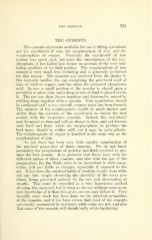Page 697 - My FlipBook
P. 697
THE CEMENTS. 355
THE CEMENTS.
The cements at present available for use in iSlling operations
are the oxychlorid of zinc, the oxyphosphate of zinc, and the
oxyphosphate of copper. Formerly the oxychlorid of zinc
cement was much used, but since the introduction of the oxy-
phosphate, it has fallen into disuse on account of the very irri-
tating qualities of its fluid portion. The oxyphosphate of zinc
cement is very much less irritating and is generally preferred
for this reason. The cements are received from the dealer in
two separate bottles, the one containing the powdered oxid of
zinc, or oxid of copper, and the other the prepared phosphoric
acid. In use, a small portion of the powder is placed upon a
porcelain or glass slab, and a drop or two of fluid is placed beside
The two are then drawn together and thoroughly mixed by
it.
rubbing them together with a spatula. This spatulation should
be continued until a very smooth, creamy mass has been fonned.
The mixture of the oxyphosphate should be much thicker and
stiffer than the mixture of the oxychlorid to obtain the best
results with the respective cements. Indeed, the oxychlorid
may be mixed so thin and soft as almost to flow, and yet become
very hard and firm; while the oxyjihosphate, to produce the
best mass, should be rather stiff, yet it may be quite plastic.
The oxyphosphate of copper is handled in the same way as the
oxyphosphate of zinc.
As yet there has been very little careful examination of
the physical properties of these cements. We do not know
accurately the proportions of powder and fluid required to jjro-
duce the best results. It is probable that these vary with the
different makes of these cements, and also with the age of the
preparation, for the fliaids seem to be inconstant in their prop-
erties, and are liable to changes, especially if exposed to the
air. It has been the constant habit of dentists to mix them with-
out any rule, simply observing the plasticity of the mass pro-
duced, being governed entirely by the eye and observation of
results. This must be regarded as a very inaccurate method
of using this material, but so long as we are without more accu-
rate knowledge of it than this gives, we can only follow it. Very
recently some work has been done on the physical properties
of the cements, and it has been shown that most of the cements
are readily permeated by moisture, while some are not, and also
that some of the cements will shrink badly while hardening


